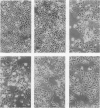Abstract
We have studied the actions of C-1311, an imidazoacridinone analogue with potent in vivo antitumour activity, against a human tumour line (HeLa S3), in an examination of the events associated with the lethality of this agent. Continuous exposures (24 h) induced complete G2 arrest, although the concentration range of this effect was narrow, with elevation of the drug level inducing additional and increasing impediment to S-phase transit. Acute treatments (3 h) revealed that cells exposed to drug levels, which first induced persistent G2 arrest (0.5 microgram ml-1), subsequently died from this compartment, while doses exceeding these levels (1.0 microgram ml-1), paradoxically, did not cause the same extensive cell death. We explain our findings on the proposition that this particular mode of cell death is dependent upon inappropriate activation of the primed mitotic machinery-specifically the hyperphosphorylated p34cdc2/cyclin B complex-assembled within G2, but that impediment to genomic replication at higher doses inhibits assembly of this complex, and hence prevents cell death. Our results demonstrate that high dose does not necessarily correlate with increased cell death, while at the same time providing further evidence for the importance of events normally associated with the G2/M transition in DNA damage-induced tumour cell death.
Full text
PDF
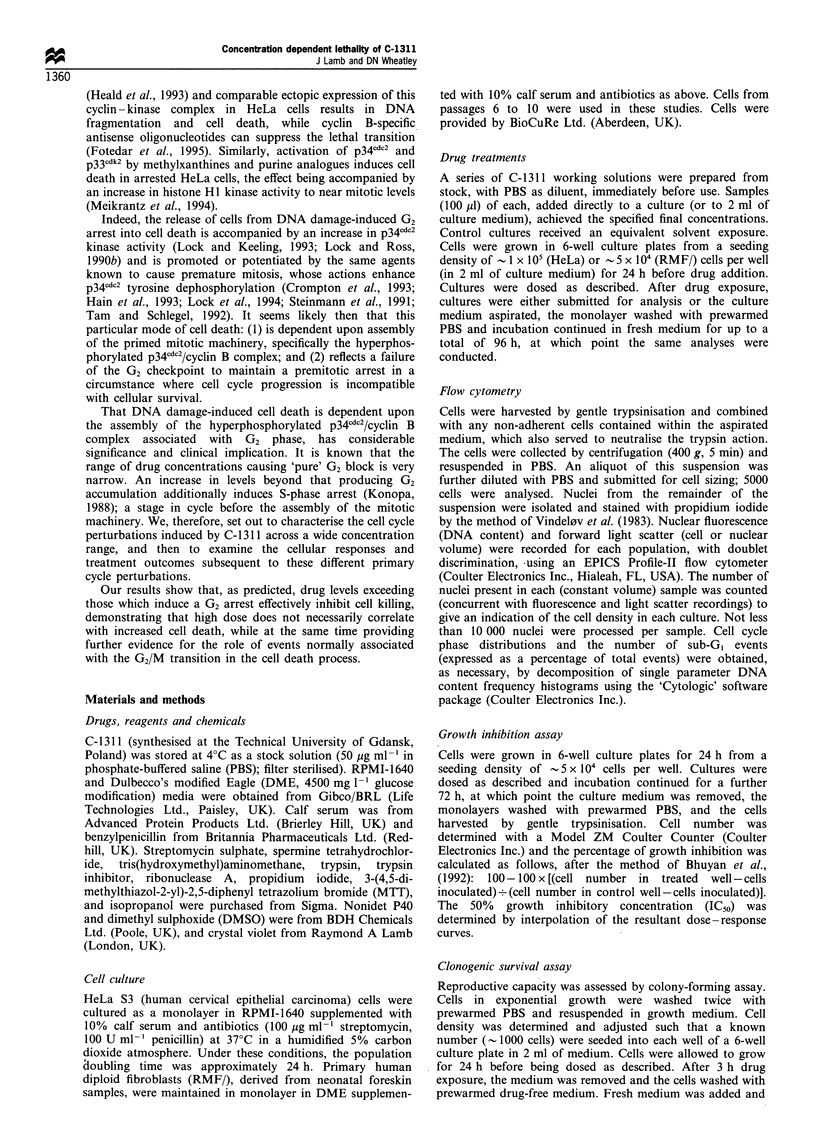
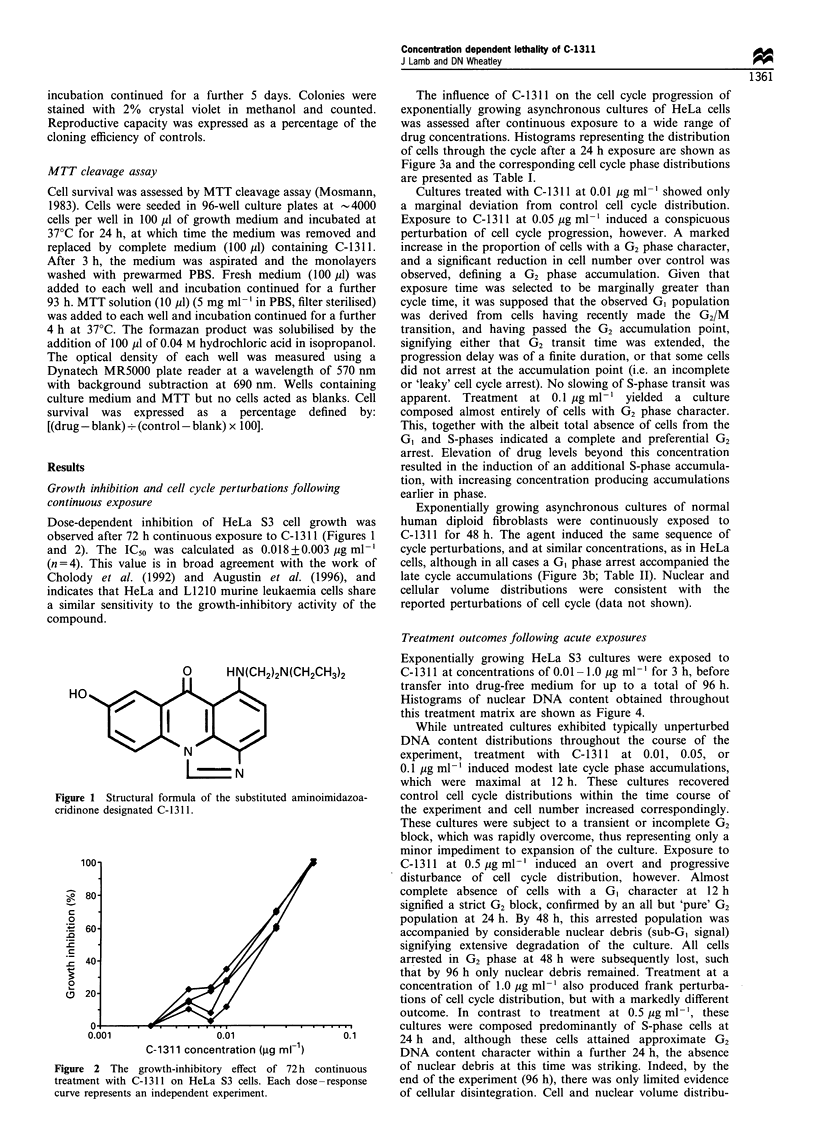
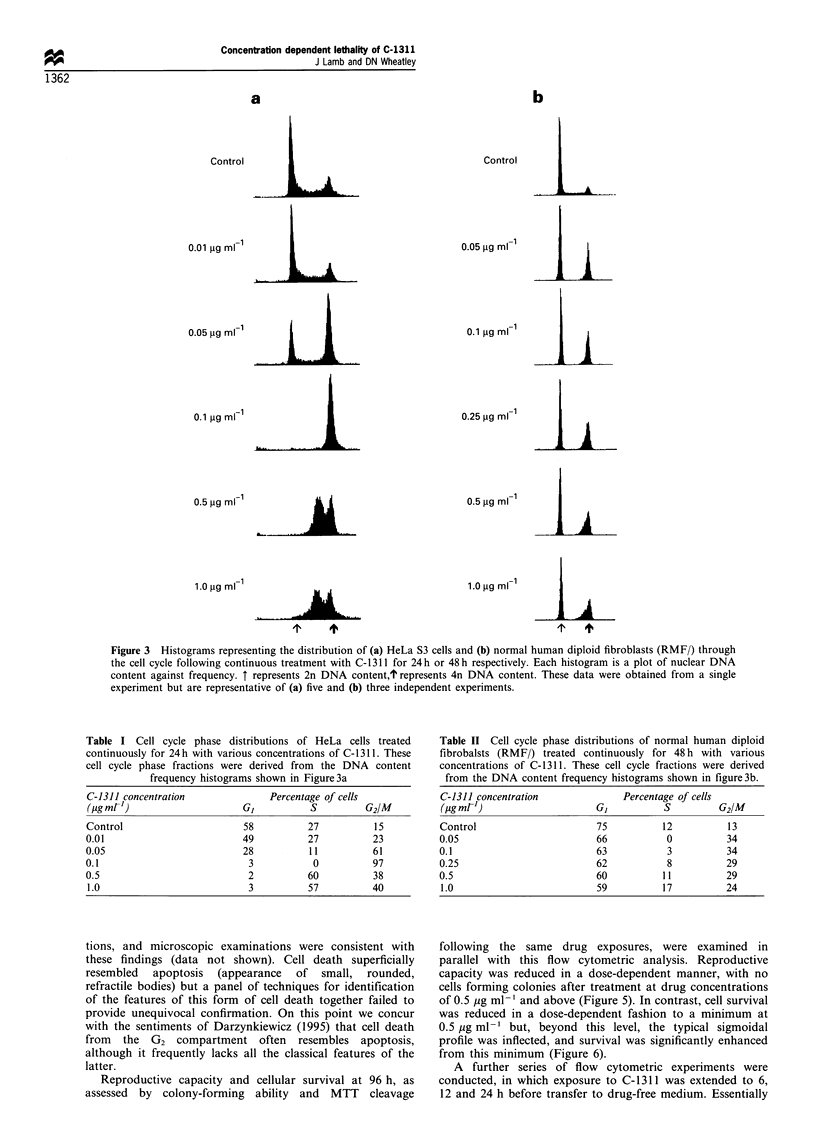
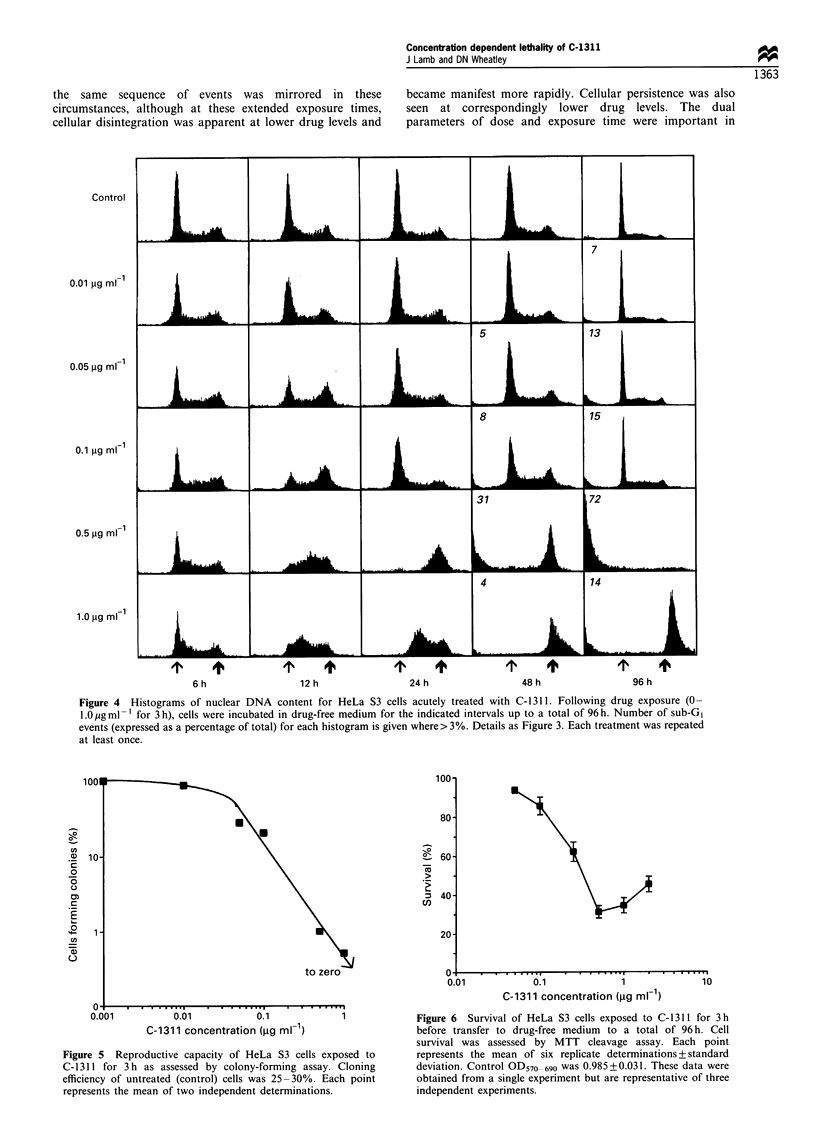
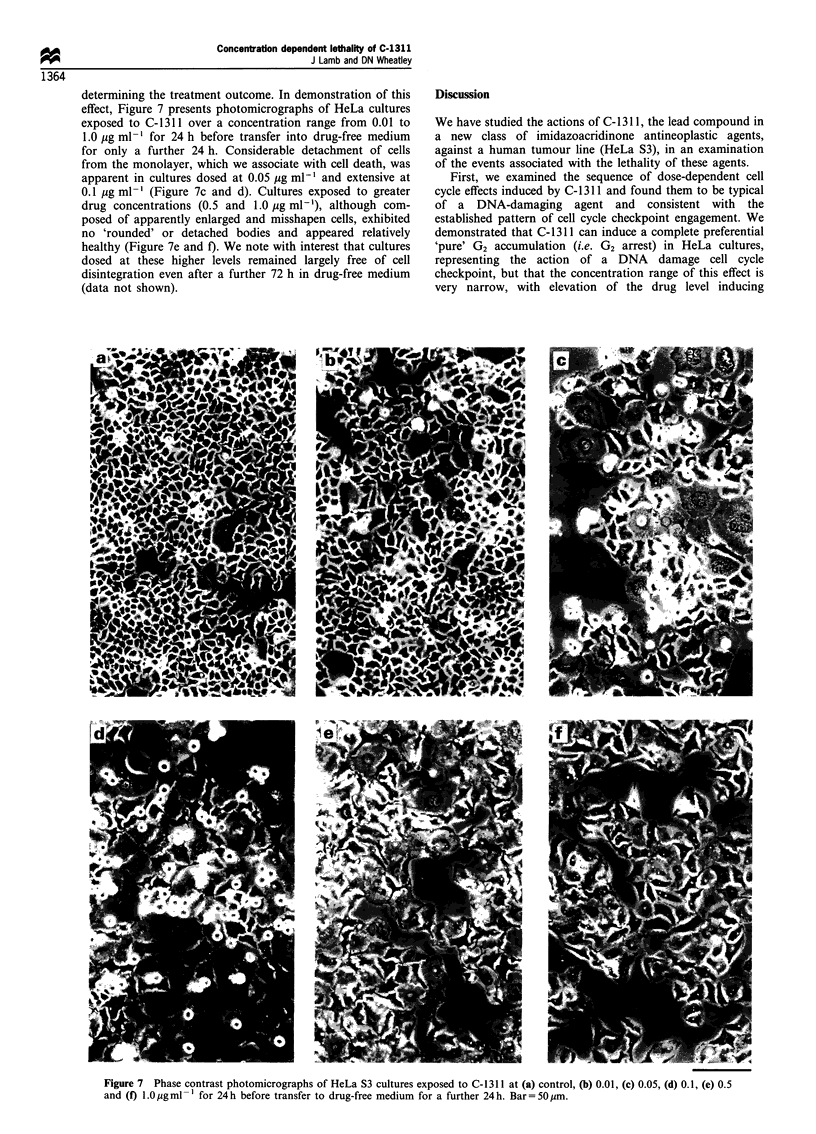
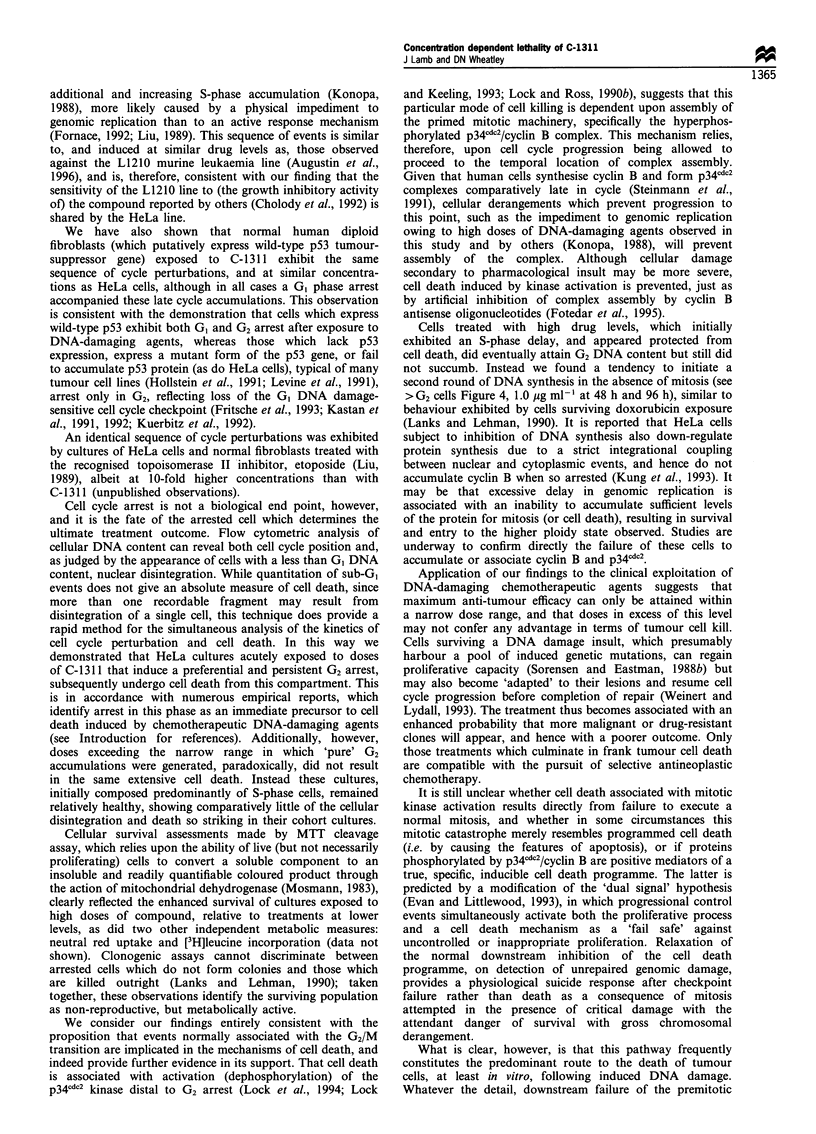
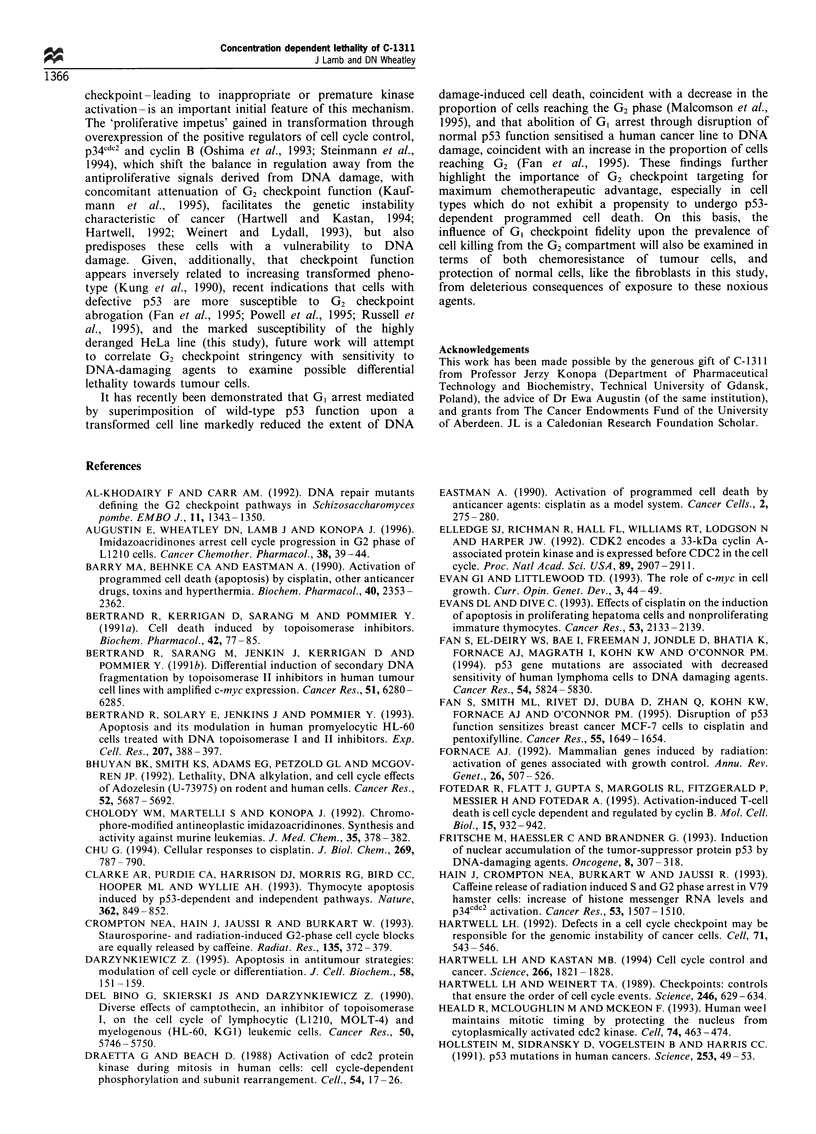
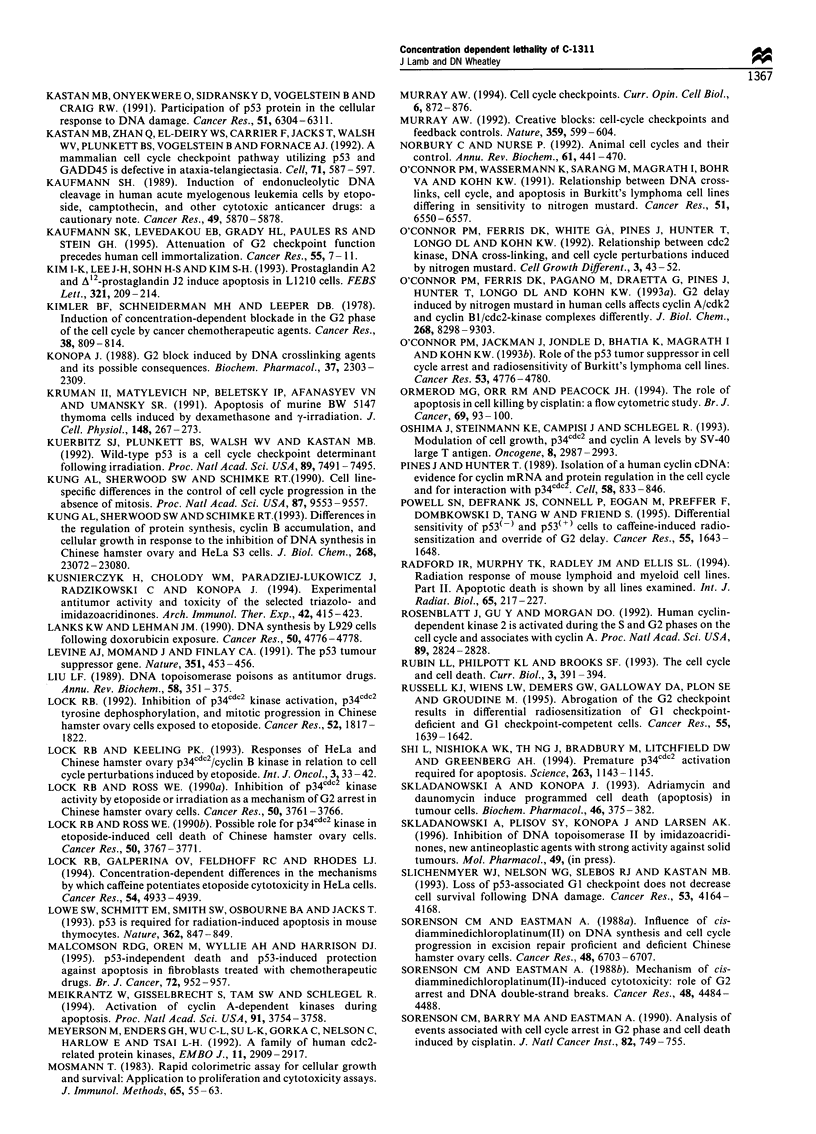

Images in this article
Selected References
These references are in PubMed. This may not be the complete list of references from this article.
- Augustin E., Wheatley D. N., Lamb J., Konopa J. Imidazoacridinones arrest cell-cycle progression in the G2 phase of L1210 cells. Cancer Chemother Pharmacol. 1996;38(1):39–44. doi: 10.1007/s002800050445. [DOI] [PubMed] [Google Scholar]
- Barry M. A., Behnke C. A., Eastman A. Activation of programmed cell death (apoptosis) by cisplatin, other anticancer drugs, toxins and hyperthermia. Biochem Pharmacol. 1990 Nov 15;40(10):2353–2362. doi: 10.1016/0006-2952(90)90733-2. [DOI] [PubMed] [Google Scholar]
- Bertrand R., Kerrigan D., Sarang M., Pommier Y. Cell death induced by topoisomerase inhibitors. Role of calcium in mammalian cells. Biochem Pharmacol. 1991 Jun 21;42(1):77–85. doi: 10.1016/0006-2952(91)90683-v. [DOI] [PubMed] [Google Scholar]
- Bertrand R., Sarang M., Jenkin J., Kerrigan D., Pommier Y. Differential induction of secondary DNA fragmentation by topoisomerase II inhibitors in human tumor cell lines with amplified c-myc expression. Cancer Res. 1991 Dec 1;51(23 Pt 1):6280–6285. [PubMed] [Google Scholar]
- Bertrand R., Solary E., Jenkins J., Pommier Y. Apoptosis and its modulation in human promyelocytic HL-60 cells treated with DNA topoisomerase I and II inhibitors. Exp Cell Res. 1993 Aug;207(2):388–397. doi: 10.1006/excr.1993.1206. [DOI] [PubMed] [Google Scholar]
- Bhuyan B. K., Smith K. S., Adams E. G., Petzold G. L., McGovren J. P. Lethality, DNA alkylation, and cell cycle effects of adozelesin (U-73975) on rodent and human cells. Cancer Res. 1992 Oct 15;52(20):5687–5692. [PubMed] [Google Scholar]
- Cholody W. M., Martelli S., Konopa J. Chromophore-modified antineoplastic imidazoacridinones. Synthesis and activity against murine leukemias. J Med Chem. 1992 Jan 24;35(2):378–382. doi: 10.1021/jm00080a026. [DOI] [PubMed] [Google Scholar]
- Chu G. Cellular responses to cisplatin. The roles of DNA-binding proteins and DNA repair. J Biol Chem. 1994 Jan 14;269(2):787–790. [PubMed] [Google Scholar]
- Clarke A. R., Purdie C. A., Harrison D. J., Morris R. G., Bird C. C., Hooper M. L., Wyllie A. H. Thymocyte apoptosis induced by p53-dependent and independent pathways. Nature. 1993 Apr 29;362(6423):849–852. doi: 10.1038/362849a0. [DOI] [PubMed] [Google Scholar]
- Crompton N. E., Hain J., Jaussi R., Burkart W. Staurosporine- and radiation-induced G2-phase cell cycle blocks are equally released by caffeine. Radiat Res. 1993 Sep;135(3):372–379. [PubMed] [Google Scholar]
- Darzynkiewicz Z. Apoptosis in antitumor strategies: modulation of cell cycle or differentiation. J Cell Biochem. 1995 Jun;58(2):151–159. doi: 10.1002/jcb.240580204. [DOI] [PubMed] [Google Scholar]
- Del Bino G., Skierski J. S., Darzynkiewicz Z. Diverse effects of camptothecin, an inhibitor of topoisomerase I, on the cell cycle of lymphocytic (L1210, MOLT-4) and myelogenous (HL-60, KG1) leukemic cells. Cancer Res. 1990 Sep 15;50(18):5746–5750. [PubMed] [Google Scholar]
- Draetta G., Beach D. Activation of cdc2 protein kinase during mitosis in human cells: cell cycle-dependent phosphorylation and subunit rearrangement. Cell. 1988 Jul 1;54(1):17–26. doi: 10.1016/0092-8674(88)90175-4. [DOI] [PubMed] [Google Scholar]
- Eastman A. Activation of programmed cell death by anticancer agents: cisplatin as a model system. Cancer Cells. 1990 Aug-Sep;2(8-9):275–280. [PubMed] [Google Scholar]
- Elledge S. J., Richman R., Hall F. L., Williams R. T., Lodgson N., Harper J. W. CDK2 encodes a 33-kDa cyclin A-associated protein kinase and is expressed before CDC2 in the cell cycle. Proc Natl Acad Sci U S A. 1992 Apr 1;89(7):2907–2911. doi: 10.1073/pnas.89.7.2907. [DOI] [PMC free article] [PubMed] [Google Scholar]
- Evan G. I., Littlewood T. D. The role of c-myc in cell growth. Curr Opin Genet Dev. 1993 Feb;3(1):44–49. doi: 10.1016/s0959-437x(05)80339-9. [DOI] [PubMed] [Google Scholar]
- Evans D. L., Dive C. Effects of cisplatin on the induction of apoptosis in proliferating hepatoma cells and nonproliferating immature thymocytes. Cancer Res. 1993 May 1;53(9):2133–2139. [PubMed] [Google Scholar]
- Fan S., Smith M. L., Rivet D. J., 2nd, Duba D., Zhan Q., Kohn K. W., Fornace A. J., Jr, O'Connor P. M. Disruption of p53 function sensitizes breast cancer MCF-7 cells to cisplatin and pentoxifylline. Cancer Res. 1995 Apr 15;55(8):1649–1654. [PubMed] [Google Scholar]
- Fan S., el-Deiry W. S., Bae I., Freeman J., Jondle D., Bhatia K., Fornace A. J., Jr, Magrath I., Kohn K. W., O'Connor P. M. p53 gene mutations are associated with decreased sensitivity of human lymphoma cells to DNA damaging agents. Cancer Res. 1994 Nov 15;54(22):5824–5830. [PubMed] [Google Scholar]
- Fornace A. J., Jr Mammalian genes induced by radiation; activation of genes associated with growth control. Annu Rev Genet. 1992;26:507–526. doi: 10.1146/annurev.ge.26.120192.002451. [DOI] [PubMed] [Google Scholar]
- Fotedar R., Flatt J., Gupta S., Margolis R. L., Fitzgerald P., Messier H., Fotedar A. Activation-induced T-cell death is cell cycle dependent and regulated by cyclin B. Mol Cell Biol. 1995 Feb;15(2):932–942. doi: 10.1128/mcb.15.2.932. [DOI] [PMC free article] [PubMed] [Google Scholar]
- Fritsche M., Haessler C., Brandner G. Induction of nuclear accumulation of the tumor-suppressor protein p53 by DNA-damaging agents. Oncogene. 1993 Feb;8(2):307–318. [PubMed] [Google Scholar]
- Hain J., Crompton N. E., Burkart W., Jaussi R. Caffeine release of radiation induced S and G2 phase arrest in V79 hamster cells: increase of histone messenger RNA levels and p34cdc2 activation. Cancer Res. 1993 Apr 1;53(7):1507–1510. [PubMed] [Google Scholar]
- Hartwell L. H., Kastan M. B. Cell cycle control and cancer. Science. 1994 Dec 16;266(5192):1821–1828. doi: 10.1126/science.7997877. [DOI] [PubMed] [Google Scholar]
- Hartwell L. H., Weinert T. A. Checkpoints: controls that ensure the order of cell cycle events. Science. 1989 Nov 3;246(4930):629–634. doi: 10.1126/science.2683079. [DOI] [PubMed] [Google Scholar]
- Hartwell L. Defects in a cell cycle checkpoint may be responsible for the genomic instability of cancer cells. Cell. 1992 Nov 13;71(4):543–546. doi: 10.1016/0092-8674(92)90586-2. [DOI] [PubMed] [Google Scholar]
- Heald R., McLoughlin M., McKeon F. Human wee1 maintains mitotic timing by protecting the nucleus from cytoplasmically activated Cdc2 kinase. Cell. 1993 Aug 13;74(3):463–474. doi: 10.1016/0092-8674(93)80048-j. [DOI] [PubMed] [Google Scholar]
- Hollstein M., Sidransky D., Vogelstein B., Harris C. C. p53 mutations in human cancers. Science. 1991 Jul 5;253(5015):49–53. doi: 10.1126/science.1905840. [DOI] [PubMed] [Google Scholar]
- Kastan M. B., Onyekwere O., Sidransky D., Vogelstein B., Craig R. W. Participation of p53 protein in the cellular response to DNA damage. Cancer Res. 1991 Dec 1;51(23 Pt 1):6304–6311. [PubMed] [Google Scholar]
- Kastan M. B., Zhan Q., el-Deiry W. S., Carrier F., Jacks T., Walsh W. V., Plunkett B. S., Vogelstein B., Fornace A. J., Jr A mammalian cell cycle checkpoint pathway utilizing p53 and GADD45 is defective in ataxia-telangiectasia. Cell. 1992 Nov 13;71(4):587–597. doi: 10.1016/0092-8674(92)90593-2. [DOI] [PubMed] [Google Scholar]
- Kaufmann S. H. Induction of endonucleolytic DNA cleavage in human acute myelogenous leukemia cells by etoposide, camptothecin, and other cytotoxic anticancer drugs: a cautionary note. Cancer Res. 1989 Nov 1;49(21):5870–5878. [PubMed] [Google Scholar]
- Kaufmann W. K., Levedakou E. N., Grady H. L., Paules R. S., Stein G. H. Attenuation of G2 checkpoint function precedes human cell immortalization. Cancer Res. 1995 Jan 1;55(1):7–11. [PubMed] [Google Scholar]
- Kim I. K., Lee J. H., Sohn H. W., Kim H. S., Kim S. H. Prostaglandin A2 and delta 12-prostaglandin J2 induce apoptosis in L1210 cells. FEBS Lett. 1993 Apr 26;321(2-3):209–214. doi: 10.1016/0014-5793(93)80110-g. [DOI] [PubMed] [Google Scholar]
- Kimler B. F., Schneiderman M. H., Leeper D. B. Induction of concentration-dependent blockade in the G2 phase of the cell cycle by cancer chemotherapeutic agents. Cancer Res. 1978 Mar;38(3):809–814. [PubMed] [Google Scholar]
- Konopa J. G2 block induced by DNA crosslinking agents and its possible consequences. Biochem Pharmacol. 1988 Jun 15;37(12):2303–2309. doi: 10.1016/0006-2952(88)90355-3. [DOI] [PubMed] [Google Scholar]
- Kruman I. I., Matylevich N. P., Beletsky I. P., Afanasyev V. N., Umansky S. R. Apoptosis of murine BW 5147 thymoma cells induced by dexamethasone and gamma-irradiation. J Cell Physiol. 1991 Aug;148(2):267–273. doi: 10.1002/jcp.1041480212. [DOI] [PubMed] [Google Scholar]
- Kuerbitz S. J., Plunkett B. S., Walsh W. V., Kastan M. B. Wild-type p53 is a cell cycle checkpoint determinant following irradiation. Proc Natl Acad Sci U S A. 1992 Aug 15;89(16):7491–7495. doi: 10.1073/pnas.89.16.7491. [DOI] [PMC free article] [PubMed] [Google Scholar]
- Kung A. L., Sherwood S. W., Schimke R. T. Cell line-specific differences in the control of cell cycle progression in the absence of mitosis. Proc Natl Acad Sci U S A. 1990 Dec;87(24):9553–9557. doi: 10.1073/pnas.87.24.9553. [DOI] [PMC free article] [PubMed] [Google Scholar]
- Kung A. L., Sherwood S. W., Schimke R. T. Differences in the regulation of protein synthesis, cyclin B accumulation, and cellular growth in response to the inhibition of DNA synthesis in Chinese hamster ovary and HeLa S3 cells. J Biol Chem. 1993 Nov 5;268(31):23072–23080. [PubMed] [Google Scholar]
- Kuśnierczyk H., Chołody W. M., Paradziej-Lukowicz J., Radzikowski C., Konopa J. Experimental antitumor activity and toxicity of the selected triazolo- and imidazoacridinones. Arch Immunol Ther Exp (Warsz) 1994;42(5-6):415–423. [PubMed] [Google Scholar]
- Lanks K. W., Lehman J. M. DNA synthesis by L929 cells following doxorubicin exposure. Cancer Res. 1990 Aug 1;50(15):4776–4778. [PubMed] [Google Scholar]
- Levine A. J., Momand J., Finlay C. A. The p53 tumour suppressor gene. Nature. 1991 Jun 6;351(6326):453–456. doi: 10.1038/351453a0. [DOI] [PubMed] [Google Scholar]
- Liu L. F. DNA topoisomerase poisons as antitumor drugs. Annu Rev Biochem. 1989;58:351–375. doi: 10.1146/annurev.bi.58.070189.002031. [DOI] [PubMed] [Google Scholar]
- Lock R. B., Galperina O. V., Feldhoff R. C., Rhodes L. J. Concentration-dependent differences in the mechanisms by which caffeine potentiates etoposide cytotoxicity in HeLa cells. Cancer Res. 1994 Sep 15;54(18):4933–4939. [PubMed] [Google Scholar]
- Lock R. B. Inhibition of p34cdc2 kinase activation, p34cdc2 tyrosine dephosphorylation, and mitotic progression in Chinese hamster ovary cells exposed to etoposide. Cancer Res. 1992 Apr 1;52(7):1817–1822. [PubMed] [Google Scholar]
- Lock R. B., Ross W. E. Inhibition of p34cdc2 kinase activity by etoposide or irradiation as a mechanism of G2 arrest in Chinese hamster ovary cells. Cancer Res. 1990 Jun 15;50(12):3761–3766. [PubMed] [Google Scholar]
- Lock R. B., Ross W. E. Possible role for p34cdc2 kinase in etoposide-induced cell death of Chinese hamster ovary cells. Cancer Res. 1990 Jun 15;50(12):3767–3771. [PubMed] [Google Scholar]
- Lowe S. W., Schmitt E. M., Smith S. W., Osborne B. A., Jacks T. p53 is required for radiation-induced apoptosis in mouse thymocytes. Nature. 1993 Apr 29;362(6423):847–849. doi: 10.1038/362847a0. [DOI] [PubMed] [Google Scholar]
- Malcomson R. D., Oren M., Wyllie A. H., Harrison D. J. p53-independent death and p53-induced protection against apoptosis in fibroblasts treated with chemotherapeutic drugs. Br J Cancer. 1995 Oct;72(4):952–957. doi: 10.1038/bjc.1995.440. [DOI] [PMC free article] [PubMed] [Google Scholar]
- Meikrantz W., Gisselbrecht S., Tam S. W., Schlegel R. Activation of cyclin A-dependent protein kinases during apoptosis. Proc Natl Acad Sci U S A. 1994 Apr 26;91(9):3754–3758. doi: 10.1073/pnas.91.9.3754. [DOI] [PMC free article] [PubMed] [Google Scholar]
- Meyerson M., Enders G. H., Wu C. L., Su L. K., Gorka C., Nelson C., Harlow E., Tsai L. H. A family of human cdc2-related protein kinases. EMBO J. 1992 Aug;11(8):2909–2917. doi: 10.1002/j.1460-2075.1992.tb05360.x. [DOI] [PMC free article] [PubMed] [Google Scholar]
- Mosmann T. Rapid colorimetric assay for cellular growth and survival: application to proliferation and cytotoxicity assays. J Immunol Methods. 1983 Dec 16;65(1-2):55–63. doi: 10.1016/0022-1759(83)90303-4. [DOI] [PubMed] [Google Scholar]
- Murray A. W. Creative blocks: cell-cycle checkpoints and feedback controls. Nature. 1992 Oct 15;359(6396):599–604. doi: 10.1038/359599a0. [DOI] [PubMed] [Google Scholar]
- Murray A. Cell cycle checkpoints. Curr Opin Cell Biol. 1994 Dec;6(6):872–876. doi: 10.1016/0955-0674(94)90059-0. [DOI] [PubMed] [Google Scholar]
- Norbury C., Nurse P. Animal cell cycles and their control. Annu Rev Biochem. 1992;61:441–470. doi: 10.1146/annurev.bi.61.070192.002301. [DOI] [PubMed] [Google Scholar]
- O'Connor P. M., Ferris D. K., Pagano M., Draetta G., Pines J., Hunter T., Longo D. L., Kohn K. W. G2 delay induced by nitrogen mustard in human cells affects cyclin A/cdk2 and cyclin B1/cdc2-kinase complexes differently. J Biol Chem. 1993 Apr 15;268(11):8298–8308. [PubMed] [Google Scholar]
- O'Connor P. M., Ferris D. K., White G. A., Pines J., Hunter T., Longo D. L., Kohn K. W. Relationships between cdc2 kinase, DNA cross-linking, and cell cycle perturbations induced by nitrogen mustard. Cell Growth Differ. 1992 Jan;3(1):43–52. [PubMed] [Google Scholar]
- O'Connor P. M., Jackman J., Jondle D., Bhatia K., Magrath I., Kohn K. W. Role of the p53 tumor suppressor gene in cell cycle arrest and radiosensitivity of Burkitt's lymphoma cell lines. Cancer Res. 1993 Oct 15;53(20):4776–4780. [PubMed] [Google Scholar]
- O'Connor P. M., Wassermann K., Sarang M., Magrath I., Bohr V. A., Kohn K. W. Relationship between DNA cross-links, cell cycle, and apoptosis in Burkitt's lymphoma cell lines differing in sensitivity to nitrogen mustard. Cancer Res. 1991 Dec 15;51(24):6550–6557. [PubMed] [Google Scholar]
- Ormerod M. G., Orr R. M., Peacock J. H. The role of apoptosis in cell killing by cisplatin: a flow cytometric study. Br J Cancer. 1994 Jan;69(1):93–100. doi: 10.1038/bjc.1994.14. [DOI] [PMC free article] [PubMed] [Google Scholar]
- Oshima J., Steinmann K. E., Campisi J., Schlegel R. Modulation of cell growth, p34cdc2 and cyclin A levels by SV-40 large T antigen. Oncogene. 1993 Nov;8(11):2987–2993. [PubMed] [Google Scholar]
- Pines J., Hunter T. Isolation of a human cyclin cDNA: evidence for cyclin mRNA and protein regulation in the cell cycle and for interaction with p34cdc2. Cell. 1989 Sep 8;58(5):833–846. doi: 10.1016/0092-8674(89)90936-7. [DOI] [PubMed] [Google Scholar]
- Powell S. N., DeFrank J. S., Connell P., Eogan M., Preffer F., Dombkowski D., Tang W., Friend S. Differential sensitivity of p53(-) and p53(+) cells to caffeine-induced radiosensitization and override of G2 delay. Cancer Res. 1995 Apr 15;55(8):1643–1648. [PubMed] [Google Scholar]
- Radford I. R., Murphy T. K., Radley J. M., Ellis S. L. Radiation response of mouse lymphoid and myeloid cell lines. Part II. Apoptotic death is shown by all lines examined. Int J Radiat Biol. 1994 Feb;65(2):217–227. doi: 10.1080/09553009414550251. [DOI] [PubMed] [Google Scholar]
- Rosenblatt J., Gu Y., Morgan D. O. Human cyclin-dependent kinase 2 is activated during the S and G2 phases of the cell cycle and associates with cyclin A. Proc Natl Acad Sci U S A. 1992 Apr 1;89(7):2824–2828. doi: 10.1073/pnas.89.7.2824. [DOI] [PMC free article] [PubMed] [Google Scholar]
- Rubin L. L., Philpott K. L., Brooks S. F. Apoptosis: the cell cycle and cell death. Curr Biol. 1993 Jun 1;3(6):391–394. doi: 10.1016/0960-9822(93)90211-6. [DOI] [PubMed] [Google Scholar]
- Russell K. J., Wiens L. W., Demers G. W., Galloway D. A., Plon S. E., Groudine M. Abrogation of the G2 checkpoint results in differential radiosensitization of G1 checkpoint-deficient and G1 checkpoint-competent cells. Cancer Res. 1995 Apr 15;55(8):1639–1642. [PubMed] [Google Scholar]
- Shi L., Nishioka W. K., Th'ng J., Bradbury E. M., Litchfield D. W., Greenberg A. H. Premature p34cdc2 activation required for apoptosis. Science. 1994 Feb 25;263(5150):1143–1145. doi: 10.1126/science.8108732. [DOI] [PubMed] [Google Scholar]
- Skladanowski A., Konopa J. Adriamycin and daunomycin induce programmed cell death (apoptosis) in tumour cells. Biochem Pharmacol. 1993 Aug 3;46(3):375–382. doi: 10.1016/0006-2952(93)90512-u. [DOI] [PubMed] [Google Scholar]
- Slichenmyer W. J., Nelson W. G., Slebos R. J., Kastan M. B. Loss of a p53-associated G1 checkpoint does not decrease cell survival following DNA damage. Cancer Res. 1993 Sep 15;53(18):4164–4168. [PubMed] [Google Scholar]
- Sorenson C. M., Barry M. A., Eastman A. Analysis of events associated with cell cycle arrest at G2 phase and cell death induced by cisplatin. J Natl Cancer Inst. 1990 May 2;82(9):749–755. doi: 10.1093/jnci/82.9.749. [DOI] [PubMed] [Google Scholar]
- Sorenson C. M., Eastman A. Influence of cis-diamminedichloroplatinum(II) on DNA synthesis and cell cycle progression in excision repair proficient and deficient Chinese hamster ovary cells. Cancer Res. 1988 Dec 1;48(23):6703–6707. [PubMed] [Google Scholar]
- Sorenson C. M., Eastman A. Mechanism of cis-diamminedichloroplatinum(II)-induced cytotoxicity: role of G2 arrest and DNA double-strand breaks. Cancer Res. 1988 Aug 15;48(16):4484–4488. [PubMed] [Google Scholar]
- Steinmann K. E., Belinsky G. S., Lee D., Schlegel R. Chemically induced premature mitosis: differential response in rodent and human cells and the relationship to cyclin B synthesis and p34cdc2/cyclin B complex formation. Proc Natl Acad Sci U S A. 1991 Aug 1;88(15):6843–6847. doi: 10.1073/pnas.88.15.6843. [DOI] [PMC free article] [PubMed] [Google Scholar]
- Tam S. W., Schlegel R. Staurosporine overrides checkpoints for mitotic onset in BHK cells. Cell Growth Differ. 1992 Nov;3(11):811–817. [PubMed] [Google Scholar]
- Tounekti O., Pron G., Belehradek J., Jr, Mir L. M. Bleomycin, an apoptosis-mimetic drug that induces two types of cell death depending on the number of molecules internalized. Cancer Res. 1993 Nov 15;53(22):5462–5469. [PubMed] [Google Scholar]
- Tsao Y. P., D'Arpa P., Liu L. F. The involvement of active DNA synthesis in camptothecin-induced G2 arrest: altered regulation of p34cdc2/cyclin B. Cancer Res. 1992 Apr 1;52(7):1823–1829. [PubMed] [Google Scholar]
- Vindeløv L. L., Christensen I. J., Nissen N. I. A detergent-trypsin method for the preparation of nuclei for flow cytometric DNA analysis. Cytometry. 1983 Mar;3(5):323–327. doi: 10.1002/cyto.990030503. [DOI] [PubMed] [Google Scholar]
- Warters R. L. Radiation-induced apoptosis in a murine T-cell hybridoma. Cancer Res. 1992 Feb 15;52(4):883–890. [PubMed] [Google Scholar]
- Weinert T., Lydall D. Cell cycle checkpoints, genetic instability and cancer. Semin Cancer Biol. 1993 Apr;4(2):129–140. [PubMed] [Google Scholar]
- Yamagishi T., Nakaike S., Nanaumi K., Otomo S., Tsukagoshi S. The effect of NC-190, a novel antitumor compound, on the cell-cycle progression of HeLa S3 cells. Cancer Chemother Pharmacol. 1993;32(4):249–254. doi: 10.1007/BF00686168. [DOI] [PubMed] [Google Scholar]
- al-Khodairy F., Carr A. M. DNA repair mutants defining G2 checkpoint pathways in Schizosaccharomyces pombe. EMBO J. 1992 Apr;11(4):1343–1350. doi: 10.1002/j.1460-2075.1992.tb05179.x. [DOI] [PMC free article] [PubMed] [Google Scholar]



